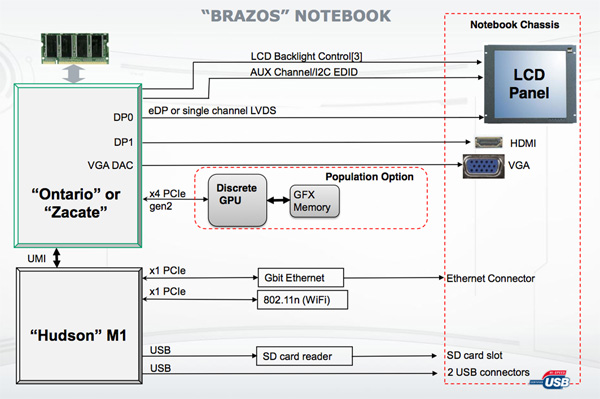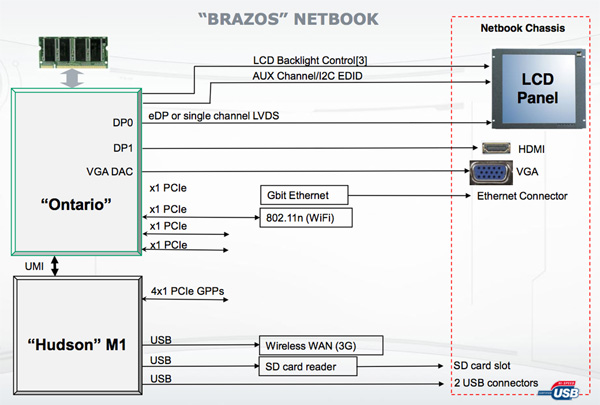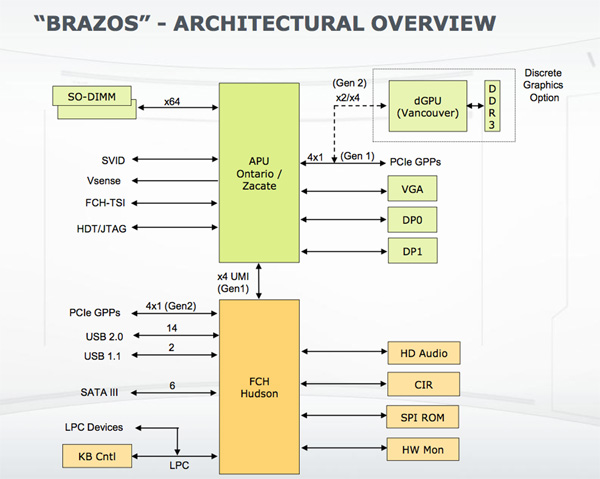Previewing AMD's Brazos, Part 1: More Details on Zacate/Ontario and Fusion
by Anand Lal Shimpi on November 9, 2010 1:09 AM ESTThe Chipset err...Fusion Controller Hub
The Zacate/Ontario APUs have an integrated PCIe interface sporting 8 lanes. Four of those lanes are used for AMD’s Universal Media Interface (UMI) - a bus that links the APU to the Hudson FCH. The remaining four can be used for discrete graphics or a combination of discrete graphics and other PCIe controllers. Both PCIe interfaces can run at gen 1 or gen 2 transfer rates.
Display output naturally stems off of the APU. You can drive two displays in tandem over any combination of VGA or Display Port/DVI/HDMI/LVDS.
As I mentioned earlier, the APU sports a single channel memory controller - but you can install up to two DIMMs on that channel. Speeds are down from the 1333MHz system we tested at IDF, DDR3-1066 is the max you’ll officially see on a Brazos system.
The Hudson FCH supplies up to 14 USB 2.0 ports, 6 x 6Gbps SATA ports and another 4 PCIe lanes. The FCH is based on AMD’s SB800 series of South Bridges. Despite the small size, this is a full featured platform.
From the looks of it, AMD has all of the right ingredients for some very competitive entries in the mainstream and ultraportable notebook markets. Now it’s just up to the OEMs to build something cool out of it.
Check back in about a week for the full rundown on Zacate performance.













106 Comments
View All Comments
Anand Lal Shimpi - Tuesday, November 9, 2010 - link
Fixed :)Take care,
Anand
hvakrg - Tuesday, November 9, 2010 - link
Is there any news on wether or not these Atom competitios will be able to bitstream audio?jabber - Tuesday, November 9, 2010 - link
....had to play on looks a little more complete than the spaghetti fest you chaps got.ET - Tuesday, November 9, 2010 - link
I was hoping that Ontario will bring a significant performance jump over dual core Atom + Ion 2. While there's still a chance it will be faster, I don't think it will be by much.I guess I will have to continue to wait (maybe forever) for a low end platform that would be good for basic gaming. I would happily give up DX11 to get twice as many DX9 cores.
Aone - Tuesday, November 9, 2010 - link
What will we see if we pair mobile Athlon with mobile discrete Radeon 54xx?Will Brazos have the same perf, better or worse?
Lolimaster - Tuesday, November 9, 2010 - link
Fusion Ontario/Zacate has the same performance of current Athlon II / Turion II Neo (same performance as regular (Athlon II).Zacate GPU has lower clocks than of HD5400(500Mhz vs 650Mhz). That's the main difference.
Why people mention CULV when Athlon II / Turion II are there and destroy those options as a cpu/gpu combo(equal cpu perf. way way better gpu perf.)
80SP AMD GPU already surpass ION2 GPU.
ET
What dissapointing? Look any comparison of the current 45nm Neo's, it's a slaughter for the poor Atoms, you'll see the same slaughter with Brazos but with improved battery life and the better gpu(twice the HD4250)
Shadowmaster625 - Tuesday, November 9, 2010 - link
If that thing really uses 4.7W its game over for AMD. No way should that part consume more than a watt. It should not even be there at all. Cant netbook manufacturers skip it entirely, and just go with a low power usb chip instead? What else do you need the FCH for on a netbook or a tablet?llllllllll - Tuesday, November 9, 2010 - link
Eh, the range was 2.7-4.7W TDP, which doesn't imply average power, just max for designing the enclosure.Also, considering 3W is typical for a DIMM of memory, and this thing is driving up multiple SATA, PCI-E, & USB ports (which remember, you have to be able to charge devices over USB), doesn't seem unreasonable that under load it would draw that much power.
Zstream - Tuesday, November 9, 2010 - link
How did you come to this conclusion?"Zacate takes the top two SKUs, while Ontario makes up the bottom two. The difference in TDP is entirely based on the clock speed of the CPU and GPU. And here is my concern. While a pair of Bobcats running at 1.6GHz are just awesome, drop the clock to 1.0GHz and I start getting concerned about performance. AMD didn’t let us test the C-50 but I’m curious to see what the margin of victory will be over Atom at that speed."
If you believe it is 100% on clock speed, we have a ton of leakage.
JarredWalton - Tuesday, November 9, 2010 - link
Doubling the maximum GPU speed and increasing CPU speed 60%, plus added voltage to get it to run properly, could easily result in a doubling of maximum power use.